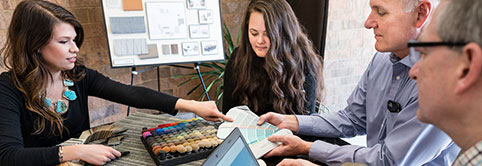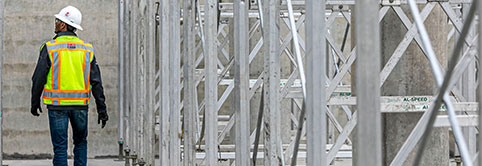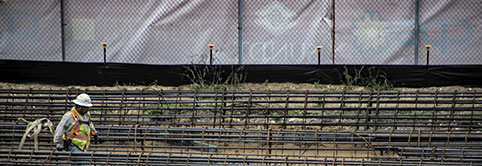Big Room
Introduction to Big Room
In construction projects, siloed communication can be the death knell for projects that produce value to stakeholders. Poor communication can make implementing Lean concepts essentially impossible, as teams are unable to relay process changes, discuss logistics, and more.
Construction projects are complex things, often with dozens or even hundreds of people across multiple different teams working in different locations. Communication can break down especially easily in these settings, and that can make the completion of work difficult for people, or may make the implementation of a new idea or rule difficult to relay.
The goal of Lean is to eliminate these communication silos and to get team members back to the basics of effective working communication. One of the ways this is best accomplished is through a Big Room approach.
What is Big Room?
Big Room – called “Obeya” in Japanese – is a project approach of bringing key individuals together to speed communication and decision-making, and to reduce siloed thinking and approaches. Big Room refers to the approach rather than the physical space where these discussions occur – simply co-locating in a room or holding a meeting with team members is not sufficient to be considered a Big Room approach.
Big Room Explained
The term Big Room is a concept people often get hung up on – even though this approach is called “Big Room” it does not need to literally take place in a big room. It is also not enough to simply meet in a big room together to say you are having a Big Room session, it is about how you spend the time in that setting.
The ultimate purpose of a Big Room approach is that the key stakeholders of the project are co-located in one room together having productive, intentional work sessions where they are making key decisions and actively advancing the project towards meeting the Conditions of Satisfaction.
Big Room sessions are often quite long, taking upwards of a half-day and in many cases, a full day of work (or multiple consecutive days of work).
Elements of Big Room Sessions
Who
The team members who participate in the Big Room should shift according to the needs of the project and whose presence will provide value to the work being done at the time. In the spirit of avoiding waste, it is crucial to only include members of the team who can provide value to or derive value from the subject at hand for each session. This may mean that some team members are consistently included in sessions, while others may be invited more occasionally.
When
Big Room sessions should begin as soon as decisions are being made on a project, even if the entirety of the team is not formed yet.
At its core, Big Room is a scheduled and recurring event or session. Given that its purpose is to break down the silos that normally prevent key stakeholders from communicating, having these meetings become a regular part of the project process to open up those lines of communication is crucial.
The frequency of Big Room sessions varies from project-to-project and team-to-team. Some teams in smaller projects may find that a half-day a week is a sufficient amount of time to spend in a Big Room setting, while others may prefer to spend multiple consecutive days in Big Room sessions, getting work done together.
Where
Big Room meetings can occur completely in-person or in a hybrid setting, with some team members being virtual. It’s recommended that as many members as possible be in-person, as being co-located is a key facet of the Big Room approach.
Team members participating in Big Room sessions should be seated in a way that facilitates productive discussion. Often this means seats are arranged in a circular fashion where everyone can view the necessary boards, visuals, and other materials.
Why
The Conditions of Satisfaction should drive all decision-making. Big Room sessions keep team members focused on the CoS while also providing them with an opportunity to discuss ideas for innovation, make key decisions, and problem-solve.
Without a Big Room approach, team members may waste time waiting for someone else to respond or to take action, and these communication silos can dramatically slow down work and get in the way of process and flow.
Big Room sessions allow key stakeholders to work together and to create a plan of attack for difficult pieces of a project that require collaboration.
How
When operating in a Big Room setting, it’s crucial to have a well-established agenda to ensure that work is being done. The team should collaborate on the creation of the agenda well in advance of the Big Room session, allowing everyone involved to provide input on the work that will be done.
It is important for the agenda to include set, measurable goals and for the session to be well-facilitated.
Use visual displays such as Kanban boards and diagrams to help team members visualize the work being done.
The OODA Loop
The OODA Loop, which stands for Observe-Orient-Decide-Act was developed by U.S. Air Force Colonel John Boyd, and the concept can be easily applied to how Big Room sessions operate.
The Big Room provides a space for the team to:
1. See the situation (Observe)
The team introduces a problem that is in need of a group decision.
2. Grasp the situation (Orient)
The team gathers all the necessary facts and variables surrounding the situation, possibly including a Plus/Delta list or another form of fact-identifying and discussion facilitation to help the team come together on a decision.
3. Make aligned decisions (Decide)
The team comes to a decision based on the outlined facts and discussion.
4. Take action (Act)
The team implements the decision.
The team then moves onto another topic and starts the process over again, maintaining the “loop.” This concept shares a lot of similarities with the Plan-Do-Check-Adjust (PDCA) cycle, which is a Lean tool for process improvement.
Benefits of Implementing a Big Room Strategy
- Supports cross-functional high-performing teams in advancing the work, allowing the team to work more efficiently and to come to decisions armed with as much information as possible through collaboration.
- Adds value by driving down overall project costs, which is a natural benefit of reducing the waste that comes from siloed communication and poor processes.
- Facilitates the rapid advancement of work in a short time frame. The goal of Big Room meetings is not simply to discuss work, but to actually actively do work together that advances the project forward.
- Enhances the collaborative brainpower of the team. Unused Creativity of Team Members is one of the 8 Wastes of Lean and is unfortunately extremely common in design and construction projects. By getting everyone together into one room to conduct work together, team members have the opportunity to share their innovations to complex problems.
- Aligns team members with the Conditions of Satisfaction and ensures that all decisions made are with the goal of Optimizing the Whole.
Lean Assessments
How strong is your Lean knowledge? Take a Lean assessment to determine your current state so you have a baseline for improvement. Lean assessments are available for individuals, teams, and organizations alike. Whether you’re new to Lean or are an experienced Lean practitioner, Lean assessments are a great way to get started at LCI!
TAKE ASSESSMENTMore Lean Topics
From 5s to IPD, explore popular Lean design and construction topics below.




